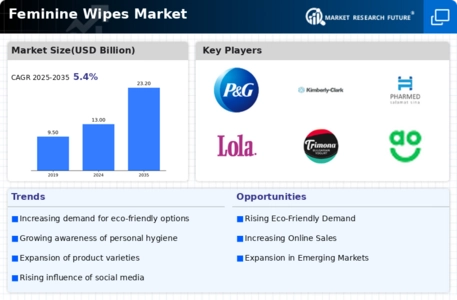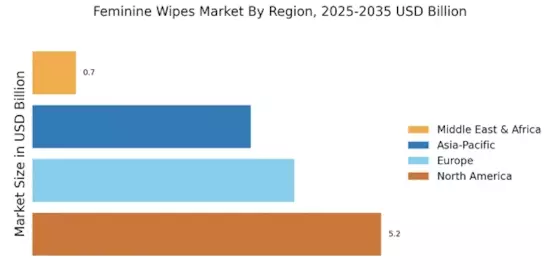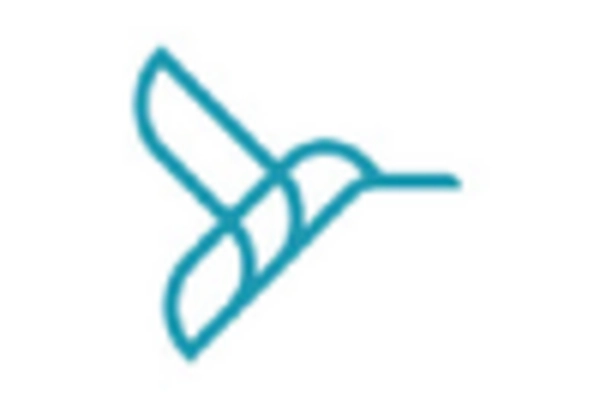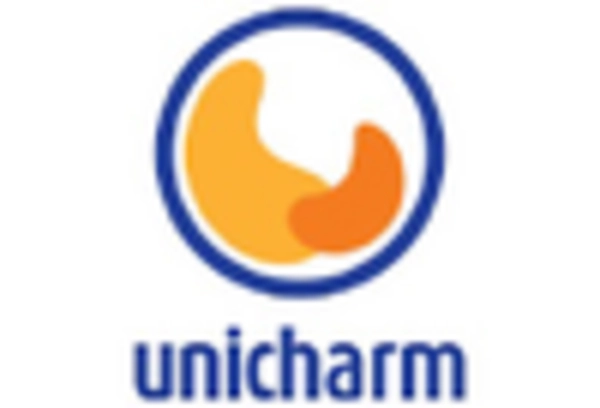Convenience and Portability
The convenience and portability of feminine wipes serve as a significant driver for the Feminine Wipes Market. In today's fast-paced lifestyle, women seek products that can easily fit into their daily routines. Feminine wipes offer a practical solution for on-the-go cleansing, making them an attractive option for busy women. The market data suggests that the wipes segment is expected to account for a substantial share of the feminine hygiene market, driven by the need for quick and effective personal care solutions. As urbanization continues to rise, the demand for portable hygiene products is likely to increase, further propelling the growth of the Feminine Wipes Market.
Expansion of Retail Channels
The expansion of retail channels is a vital driver for the Feminine Wipes Market. With the rise of e-commerce and the proliferation of online shopping platforms, consumers now have greater access to a wide range of feminine hygiene products. This shift is particularly beneficial for the Feminine Wipes Market, as it allows brands to reach a broader audience and cater to diverse consumer needs. Additionally, traditional retail outlets are also enhancing their product offerings, ensuring that feminine wipes are readily available to consumers. The increased accessibility and variety of products are likely to stimulate growth in the Feminine Wipes Market, as more women discover and purchase these essential hygiene products.
Rising Awareness of Personal Hygiene
The increasing awareness regarding personal hygiene among women is a pivotal driver for the Feminine Wipes Market. As women become more informed about the importance of maintaining cleanliness, the demand for feminine hygiene products, including wipes, is likely to surge. Reports indicate that the feminine hygiene market is projected to grow at a compound annual growth rate of approximately 6.5% over the next few years. This heightened awareness is not only fostering a shift towards premium products but also encouraging manufacturers to innovate and enhance their offerings. Consequently, the Feminine Wipes Market is witnessing a transformation, with brands focusing on natural ingredients and eco-friendly packaging to cater to the evolving preferences of consumers.
Influence of Social Media and Marketing
The influence of social media and targeted marketing strategies is reshaping the Feminine Wipes Market. Brands are leveraging platforms like Instagram and TikTok to engage with consumers, promoting their products through influencers and user-generated content. This trend appears to be effective, as younger demographics are increasingly turning to social media for product recommendations. The Feminine Wipes Market is likely to benefit from this shift, as brands that effectively utilize digital marketing strategies can enhance their visibility and reach. Furthermore, the rise of e-commerce has made it easier for consumers to access a variety of feminine wipes, thereby expanding the market's potential.
Growing Demand for Eco-Friendly Products
The growing demand for eco-friendly and sustainable products is a crucial driver for the Feminine Wipes Market. As consumers become more environmentally conscious, there is a noticeable shift towards products that are biodegradable and made from natural materials. This trend is reflected in the increasing number of brands that are introducing eco-friendly feminine wipes, which cater to the preferences of environmentally aware consumers. Market analysis indicates that the eco-friendly segment is expected to witness significant growth, as more women prioritize sustainability in their purchasing decisions. Consequently, the Feminine Wipes Market is adapting to these changes by innovating and offering products that align with eco-conscious values.


















Leave a Comment